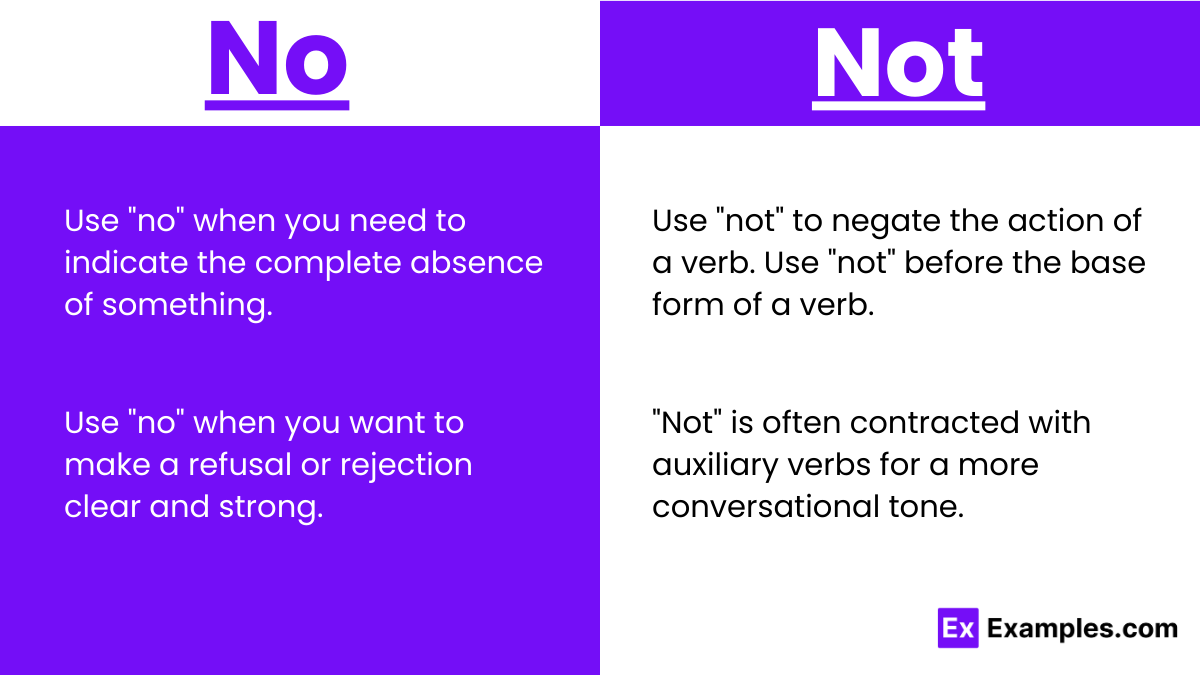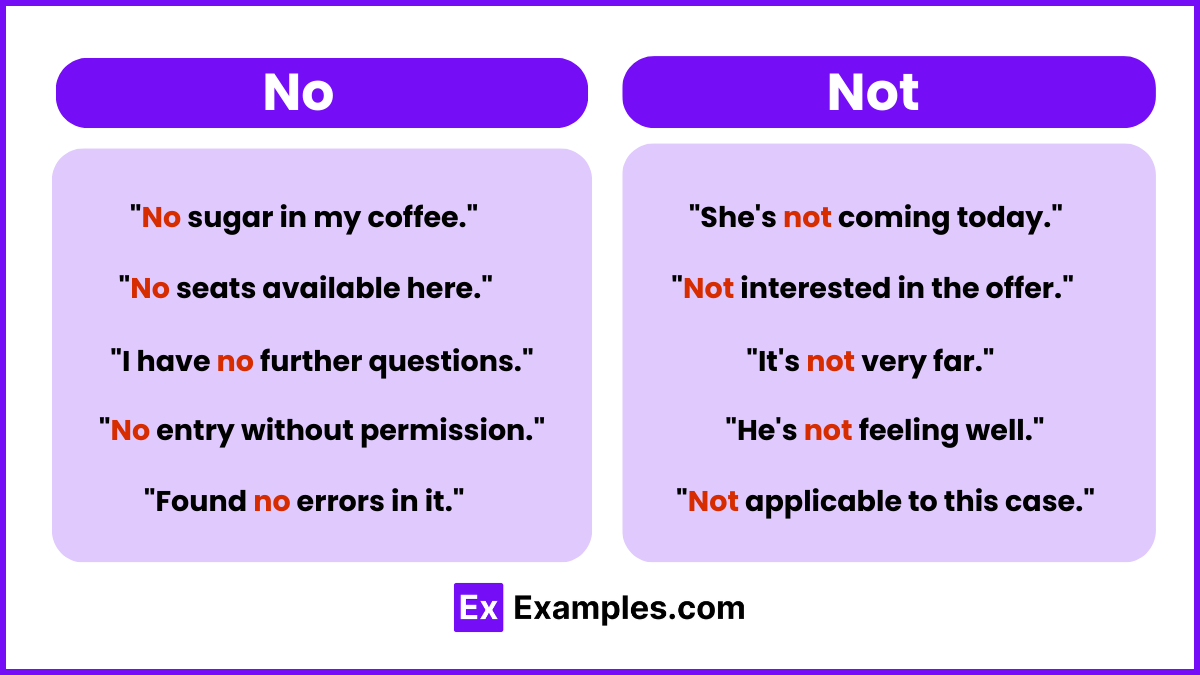No vs Not – Meanings, Differences, Examples, Usage
“Ever mixed up ‘no‘ and ‘not‘ in a sentence? This article is here to help! We’ll quickly show you how ‘no‘ is for denying things, like in ‘no milk,’ and ‘not‘ is for negation, like in ‘not going.’ ‘No,’ a direct way to express denial or absence, and ‘not,’ a versatile tool for negation, are dissected here to reveal their distinct roles in language. From negating actions with ‘not’ to denying nouns with ‘no,’ we’ll unpack the meanings and uses of these words in a way that’s easy to grasp.
No and Not – Meanings
- No: “No” is often used as a determiner or an adverb, typically to negate a noun or to provide a negative response to a question. It can indicate the absence of something or deny permission.
- Not: “Not” is an adverb used to make a verb, adjective, or other adverb negative. It’s employed to reverse the state described by the verb or to introduce negation into a sentence structure.
Summary
“No” is typically used before a noun to indicate the absence of something, like in “no sugar.” It’s also the word you’d use to answer a yes/no question negatively. On the other hand, “not” is used to make a verb negative, as in “I do not like,” or to negate adjectives and adverbs, such as “not happy” or “not well.” It’s about whether you’re negating a thing (“no“) or an action, quality, or condition (“not“). Understanding when to use each can help make your communication clear and effective.
How to Pronounce No and Not
- No: Pronounced as /noʊ/ (no).
- Not: Pronounced as /nɒt/ (not).
The pronunciation of these words is quite straightforward, with the primary difference being the vowel sound.
Differences between No and Not
| Aspect | No | Not |
|---|---|---|
| Grammatical Role | Determiner, Adverb | Adverb |
| Formality | Can be used in both formal and informal contexts | Primarily used in constructions requiring an adverb |
| Usage | Negates nouns, provides negative responses | Negates verbs, adjectives, and adverbs |
| Context | Direct negation, refusal, absence | Introduction of negation, reversal of state |
| Nuance | Direct and often absolute negation | Flexibly negates or modifies the statement |
How to Remember the Difference between No and Not
To differentiate between “no” and “not“, consider “no” as the direct negation of a noun or as a standalone negative response. “Not”, however, is used to negate or reverse the state of actions (verbs), qualities (adjectives), or manner (adverbs). Remember, “no” often stands alone or directly before a noun, while “not” is typically paired with verbs and adjectives.
When to Use No and Not

Usage of No
- Denoting Absence or Lack: Use “no” when you need to indicate the complete absence of something. For example, “There are no apples left in the basket” means that not a single apple is present.
- Answers to Yes/No Questions: “No” is used to provide a negative response to questions that can be answered with “yes” or “no.” For example, “Are you going to the party?” – “No.”
- Before Nouns: Place “no” directly before a noun to deny the existence or presence of the noun. For example, “She has no interest in attending the meeting.”
- To Emphasize Refusals: Use “no” when you want to make a refusal or rejection clear and strong. For example, “No, I will not accept unfair treatment.”
- With Comparatives: “No” can be used with comparatives to denote that something is not at all or in no way better, worse, etc. For example, “This solution is no better than the last one.”
Usage of Not
- To Make Verbs Negative: Use “not” to negate the action of a verb. For example, “He does not understand the instructions” negates the verb “understand.”
- With Auxiliary Verbs: “Not” is used after auxiliary verbs (be, have, do, modal verbs) to form negative sentences. For example, “She has not finished her work.”
- To Negate Adjectives and Adverbs: Place “not” before adjectives and adverbs to negate their meaning. For example, “The task is not difficult” negates the adjective “difficult.”
- In Contractions: “Not” is often contracted with auxiliary verbs for a more conversational tone. For example, “isn’t” for “is not,” “haven’t” for “have not.”
- With Infinitives: Use “not” before the base form of a verb to form a negative infinitive phrase. For example, “He decided not to go” negates the infinitive “to go.”
How to Use No and Not
No
- As a Determiner: “No” can precede nouns to negate them or indicate their absence.
- Example: No cars are allowed in the park.
Not
- With Verbs: Use “not” to negate verbs, often in conjunction with auxiliary verbs.
- Example: She does not understand.
No and Not – Examples

Examples of No
- Firstly, say no to unhealthy habits for better well-being.
- Moreover, experiencing no progress can be discouraging.
- On the other hand, no effort is wasted if lessons are learned.
- Additionally, maintain a no-compromise approach to quality.
- Finally, no news sometimes means good news.
Examples of Not
- Firstly, not all that glitters is gold, emphasizing caution.
- Besides, it’s important not to overlook small details.
- Conversely, not every risk leads to reward, urging prudence.
- Furthermore, not participating can sometimes be a strategic choice.
- In conclusion, life is not just about winning but also about learning.
Synonyms
| No | Not |
|---|---|
| None | Negate |
| Zero | Without |
| Neither | Never |
| Reject | Refuse |
| Absence | Lack |
Exercise
Fill in the blanks with either “no” or “not” to complete the sentences accurately.
- There are ___ easy answers to complex problems.
- She was ___ sure about the decision.
- ___ one understood the real reason behind his actions.
- It’s ___ just about quantity, but quality.
- ___ only did he refuse the offer, but he also suggested an alternative.
Answers
- no
- not
- No
- not
- No
FAQ’S
How Do I Use “No”?
Use “no” before nouns to indicate absence, like “no sugar” or “no problem.”
What Is the Difference Between “There Is No” and “There Is Not”?
“There is no” denies existence (e.g., “no milk”), while “there is not” negates a state or condition.
What Does “No, Not Really” Mean?
“No, not really” is a soft, indirect way of saying “no,” often used to express mild disagreement or doubt.
Is It Correct to Say “There Was No”?
Yes, “there was no” is correct when stating that something was absent in the past, like “there was no rain.”
How Could I Say “No” in a Sentence?
Say “no” to refuse or deny, e.g., “No, I can’t attend,” or to indicate absence, “There are no tickets left.”
Can I Say “Have No”?
Yes, “have no” is correct for expressing lack or absence, like “I have no time” or “We have no bread left.”


